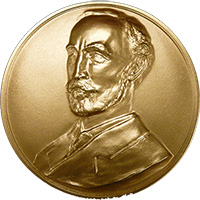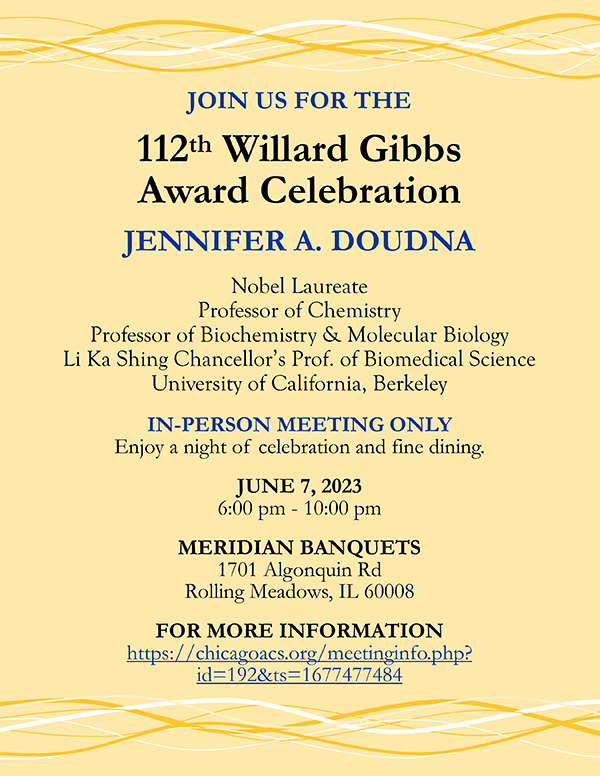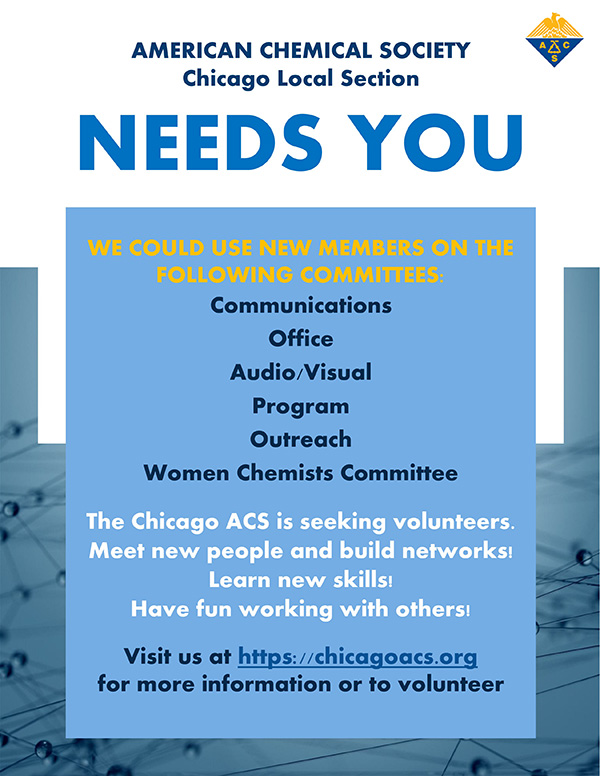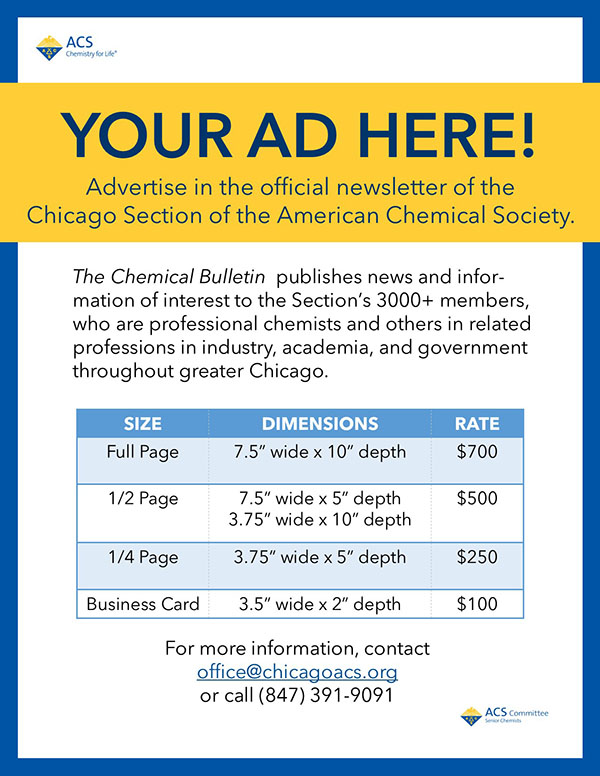The May 2023 Chemical Bulletin 
PDF of the Latest Bulletin
https://chicagoacs.org/images/downloads/Chemical_Bulletin/2023_05_chembull.pdf
Next Meeting
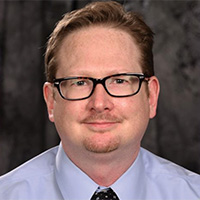
May Hybrid Monthly Meeting
Friday, May 19
5:30 - 8:45 PM CT (Lecture 7:30)
In-Person EVENT includes Free Laboratory tour
Dr. Michael Appell
Research Chemist, U.S. Department of Agriculture
Agricultural Research Service
"Greener Chemical Approaches to Reduce Mycotoxin Contamination of Food and Beverages"
ABSTRACT:
The role of the Agricultural Research Service, the USDA’s chief scientific in-house research agency spread across 90 locations, is finding solutions to agricultural problems that affect people every day, from field to table. Hundreds of chemically diverse mycotoxins produced by fungi reduce food quality and impact food security. Examples include aflatoxins in contaminated peanuts, citrinin in corn, and ochratoxin A in wine and grape juice. Several approaches are being used for detecting and combatting mycotoxins in food and drinks. One strategy for eliminating mycotoxins makes use of synthetic chemistry to produce better antifungal compounds; this tactic is aided by the use of quantitative structure–activity relationship (QSAR) modeling. For mycotoxin detection, selective receptors such as biochar, molecularly imprinted polymers (MIPs), and polymers equipped with biomimetic functions like cyclodextrins are being used to analyze minute amounts of mycotoxins in complex food and beverage matrices. These newer detection methods complement existing ones, which is important because using different techniques enables broader detection of contaminants.
PROGRAM (TWO SITES):
*Zazzo's Pizza Restaurant, 200 West Ogden Ave (US-34), Westmont, IL 60559
**The McCrone Group, 850 Pasquinelli Drive, Westmont, IL 60559. Parking Available on-site
In-Person Buffet Dinner
- House salad & bread
- Broasted chicken
- Homemade Italian meatballs
- Cheese ravioli with marinara
- Italian roasted potatoes
- Mixed veggies
- Ice cream sundae
- Non-alcoholic beverages
$30 for ACS members
$35 for nonmembers
$20 for students and postdocs
Lecture-only is free (on-site or online)
REGISTRATION
(Buffet dinner) Wed, May 11 at 12 PM
(In-person Lecture-only) Friday, May 19 at 8 PM
(Zoom Lecture-only) Friday, May 19 at 8 PM
Questions? Email us (info-at-chicagoacs.org) or contact us by phone (847-391-9091).
Meet The Speaker
Michael Appell is a Research Chemist for the U.S. Department of Agriculture, Agricultural Research Service, having joined the National Center for Agricultural Utilization Research in 2002. He received a B.S. in Biochemistry from the University of Illinois at Chicago and a Ph.D. in Medicinal Chemistry from the College of Pharmacy at the University of Illinois. He then did postdoctoral research in molecular pharmacology at the University of Illinois College of Medicine. Dr. Appell’s current research is in food safety. Food safety is important for supporting public health and reducing foodborne illness. Occasionally, agricultural commodities can be contaminated with fungi capable of producing toxins known as mycotoxins. Michael Appell’s research aims to find new ways to detect and reduce exposure to mycotoxins in food and beverages. In particular, the research addresses the limitations of existing methods for detecting toxins in popular commodities, such as corn, coffee, and fruit juices. The new approaches make use of analytical chemistry, predictive modeling, and materials science. Dr. Appell is an active member of the ACS Illinois Heartland Section, an American Chemical Society Fellow, and a Fellow of the ACS Division of Agricultural and Food Chemistry.
From the Editor's Desk

Reasons to Celebrate
Happy spring, Chicago ACS members! We hope the warmer weather has infused your days with energy and joy. Last month we celebrated Earth Day. Perhaps you commemorated the day enjoying nature or learning about algae. (The 2023 ACS theme for Chemists Celebrate Earth Week was “The Curious Chemistry of Amazing Algae.”) The changing of the seasons and Earth’s natural resources are two great reasons to celebrate.

The 112th Willard Gibbs Medal Award Celebration will be held in June rather that May. We are excited to honor Dr. Jennifer A. Doudna, Nobel Laureate, and we look forward to an enjoyable evening spent with friends and colleagues! The meeting will be in-person only, so don’t forget to register and join us for a night of celebration. See the flyer on page 7.
As always, we thank our contributors who make this newsletter special: Paul Brandt, Helen Dickinson, Ken Fivizzani, Josh Kurutz, Margaret Schott, and James Seale
- AMBER ARZADON and IRENE CESA
Photo credit: https:// www.pexels.com/photo/daylight- environment-flora-grass-261088/
Letter from the Chair
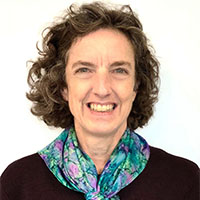
Highlights from the ACS Spring 2023 Meeting
One of the most enjoyable parts of the ACS Spring National Meeting in Indianapolis for me happened at the Indiana History Center on March 27. The occasion was the designation of a new National Historic Chemical Landmark recognizing the key role of Eli Lilly and Company in the development, scale-up, and commercialization of insulin for treating patients with diabetes. The chemical landmarks program is an initiative of the American Chemical Society. On the way out we were handed a copy of the book "Breakthrough: Elizabeth Hughes, the Discovery of Insulin, and the Making of a Medical Miracle.”
Other highlights of the national meeting for me included chance encounters with “old” friends, the inter-divisional Sci-Mix poster event, and the beautiful display of chemistry-related stamps on the Expo floor. The display was curated by Dan Rabinovich, one of our section’s past presenters. I was amazed to learn that all the ACS signage, registration booths, expo theaters, ACS store, carpets, and the enormous “Proud to be a Chemist” whiteboard are shipped by truck to each national meeting venue.
Thank you to our section members for their active and inspiring roles in the national meeting, either in person or online, as councilors, as members of national committees and subcommittees, as career presenter and counselor, and as presenters of posters and talks. Congratulations to Amy Balija, national chair of the Women Chemists Committee (WCC), for coordinating the rich and varied WCC programming at the meeting. The meeting also provided a valuable opportunity to build relationships with fellow section members.
On May 19th another new National Historic Chemical Landmark will be designated at Columbia University. The event, which is being sponsored by the New York Section, will celebrate the life and legacy of Marie Maynard Daly, the first African American woman to earn a Ph.D. in Chemistry (1947, Columbia). Dr. Daly led a highly successful and multifaceted career investigating the chemistry of histones, the role of cholesterol in atherosclerosis, and the separation of nucleobases in RNA and DNA. She was also an educator who devoted herself to increasing minority enrollments in medical and graduate schools.
- MARGARET SCHOTT

National Historic Chemical Landmarks in Illinois
- Alice Hamilton and the Development of Occupational Medicine
- Discovery and Development of Penicillin
- Noyes Laboratory at the University of Illinois, Urbana-Champaign
- Universal Oil Products (UOP) Riverside Laboratory
- Willard Libby and Radiocarbon Dating
Councilors' Report

ACS Spring Council Meeting Report
The Spring 2023 National Meeting of the ACS was held in-person in Indianapolis and virtually from March 26 - 30, 2023. The theme of this meeting was “Crossroads of Chemistry.” Dr. Judith Giordan, ACS President, presided over the Hybrid ACS Council Meeting on March 29, 2023.
The Chicago Section was represented at Council by the following nine councilors: Paul Brandt (Public Relations and Communications), Mark Cesa (International Activities), David Crumrine, Ken Fivizzani (Economic and Professional Affairs), Russell Johnson (International Activities), Fran Kravitz (Council Policy), Josh Kurutz (Chemists with Disabilities), Margy Levenberg (Meetings and Expositions), and Tim Marin.
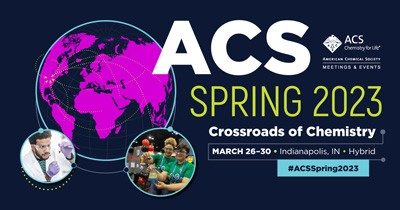
Election Results: By electronic ballot, the Council selected Dorothy J. Phillips and Florian J. Schattenmann as nominees for President-Elect in 2024. These candidates will stand for election in the Fall 2023 National Election. Diane Krone and Bonnie Lawlor for District III and Janet Bryant and Jeanette Van Emon for District VI are candidates for Director. Wayne Jones Jr., Daniel Rabinovich, Carolyn Ribes, and Joseph Stoner were also announced by Nominations and Elections as candidates for Directors-at-Large for 2024 - 2026. Council elected Daniel Rabinovich to serve on the Committee on Committees.
Committee Reports and Key Actions: On the recommendation of the Council Policy Committee, Council approved the Petition to Amend the Duties of the Council Policy Committee to authorize it to review the conduct of Councilors. On the recommendation of the Committee on Committees, and with the concurrence of the Council Policy Committee, Council approved the Petition to Amend the Duties of the Committee on Environmental Improvement to change its name to the Committee on Environment and Sustainability. On the recommendation of the Committee on Nominations and Elections, and with the concurrence of the Council Policy Committee, Council approved the Petition to Add Plan B to Council Meetings, which authorizes the postponement of voting at Council in case of technology failures or natural disasters. The Committee on Local Section Activities announced the launch of the ACS Speaker Directory, a new resource for local section leaders to access a wide range of speakers for their in-person, hybrid, and asynchronous events.
Council Special Discussion: President Giordan introduced and led a special discussion on the ongoing review of Society Committees. She sought Councilor input of positive ideas, key issues, and opportunities to improve the structure of committees. Four specific prompts were posed to Councilors for their input and suggestions:
- Ideally, for ACS to have a committee structure that is forward-thinking and able to address opportunities for members, ACS and the chemistry enterprise, we would…
- Current and future key issues impacting ACS, the chemistry enterprise, and our committees include…
- I wonder what the positive impact on committees, member involvement, and ACS would be if we were to…
- I wish that committees at ACS could…
Councilors provided their ideas and thoughts, and relevant Society units will receive this input within the next several weeks.
Meetings and Expositions: As of March 29, 2023, the Spring ACS National Meeting had 12,623 registrants (10,792 in-person and 1,831 virtual).
If you have any questions or comments about the above information, please contact me or one of your other councilors. You may contact me at [email protected].
- PAUL BRANDT
Awards

2023 Emerging Star Award Goes to
Michael Morello
Congratulations to Michael Morello of Cary, Illinois, on his selection as the 2023 Emerging Star Awardee for the Chicago ACS. Mike is currently serving his second term as Treasurer for the Chicago Section, having been elected Treasurer in 2022 and 2023. Prior to that Mike served as Director for two years (2020–2021).

The Emerging Star Award recognizes individuals with less than ten years of service to the ACS Chicago Section for exceptional contributions to the section, above and separate from other achievements either to the National ACS or to the profession of chemistry. As a member of the Chicago Board, Mike has played an influential role in the Finance Committee overseeing the financial policies for the section and developing up-to-date policies and procedures to maintain financial stability and sustainability. His contributions to the Board in the areas of project management have been especially valuable in helping the Chicago Section align its financial policies with its strategic priorities.
Mike is retired and worked at PepsiCo/The Quaker Oats Company for 38 years, where he was Global R&D Fellow and R&D Director Analytical Sciences. He received a B.S. in Chemistry from Worcester State College in 1976 and M.S. in Organic Chemistry from Iowa State University in 1980. In addition to his scientific and professional expertise in food chemistry, Mike was honored as an ACS Fellow in 2013 for his years of dedicated service to the National ACS, including as Chair and Councilor for the Division of Agricultural and Food Chemistry (AGFD). As Councilor, Mike was privileged to serve on the Committee on Meetings and Exhibitions, Committee on Divisional Activities (Chair, 2013–2016), and the Multidisciplinary Program Planning Group. Mike has co-organized seven symposia at ACS National Meetings with a special interest in sustainability and food production. He was honored as an AGFD Fellow in 2022 and continues to serve ACS governance as a division representative to the Committee on Science (ComSci) and as awards chair for AGFD.
On a personal level, Mike and his family are avid gardeners, and they especially enjoy taking advantage of theater and dining options in the Chicago area and in their travels.
- IRENE CESA, 2023 Emerging Star Award Committee Chair
I am thrilled that the Chicago Section has selected Michael Morello as winner of the 2023 Emerging Star Award. In addition to Mike’s leadership in helping to improve processes and get to the bottom of financial questions, he was also a willing volunteer at the section’s welcome counter during the 2022 Fall National Meeting in Chicago. Congratulations, Mike!
- MARGARET SCHOTT, 2023 Chicago Section Chair

“Cornucopia” from Mike Morello’s garden.
Photo credit:
https:// www.acs.org/industry/industry-matters/5th-quarter/michael-morello.html
Congratulations to our
50-, 60-, and 70-year Members!
On behalf of the entire ACS Chicago Section, I wish to extend hearty congratulations to the sixty-one individuals who have been ACS members for 50, 60 or 70 years. Each member will receive a certificate, a special lapel pin, and a permanent member card from the ACS National office in appreciation for their many years of service to the Society. In addition, registration at ACS meetings is available at no cost for members celebrating 50 or more years.
We are grateful to these members who have contributed time, talent and treasure to both ACS National and local section endeavors. Many have served in leadership and volunteer outreach roles in the Society as well as in their professional lives, including in industry, academia, government, publishing, advocacy, writing, public speaking and more. All of our 50-, 60-, and 70-year members are invited to attend the May program meeting so that we may congratulate them in person. We hope to see you there!
- MARGARET SCHOTT
50-, 60-, and 70-YEAR ACS MEMBERS
50-year Members
Carole B. Szpunar
60-year Members
70-year Members
Recent Meeting
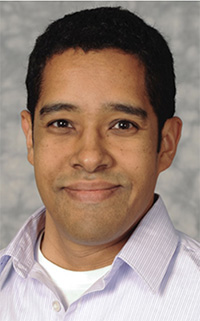
3D-Printing with Proteins
Our April Program Meeting was held virtually on April 21, 2023, with a featured presentation by Prof. Alshakim (Al) Nelson of the University of Washington. Prof. Nelson talked about the functionalization and use of bovine serum albumin (BSA), a common and inexpensive globular protein, as a starting material for plastic deposition via photopolymerization cross-linking in 3D-printers. The goal of developing protein-based plastic resins is to reduce the use of volatile and hazardous plastics in 3D printing. BSA-derived photopolymers are non-petroleum based and biodegradable, offering sustainable approaches to meet future demands in additive manufacturing.
Al Nelson described two primary approaches to developing BSA-based resins. In the first case, surface lysine residues in BSA are functionalized with methacrylate groups to obtain low-viscosity, water-soluble resins or hydrogels. The hydrogels can be cross-linked by photopolymerization using conventional 3D laser printing technology. The resulting hardened bioplastic is then subjected to thermal or mechanical denaturation to further increase its stiffness and mechanical strength. The bioplastics had better tensile strength than conventional polymer-based plastics.
A second approach developed by the Nelson lab is to copolymerize BSA directly with a polyethylene glycol diacrylate via laser photoinitiation. Mechanical compression of the resulting bioplastic unravels the globular structure of the protein and restores its “stored length,” giving it a nanoparticle structure. This process provides materials with excellent properties for use in additive manufacturing. Addition of tannic acid to the hydrogel improves the potential enzymatic biodegradability of the printed pieces.
Thank you to Dr. Nelson for speaking to the ACS Chicago Section via Zoom—looking back to nature provides unique solutions for a sustainable future!
Safety First

A Foothold on
Polyfluoroalkyl Substances
In 1962, Rachel Carson’s book Silent Spring shocked the world with revelations of widespread pesticide pollution and industrial subterfuge. A full 60 years later, humanity is busily creating the subject matter for the sequel. This time, it’s not pesticides that are the issue, but a class of toxic substances often called by their acronym: PFAS (polyfluoroalkyl substances). These chemicals are widely used in industrial and consumer products, found in everything from nonstick coatings to fire extinguisher foams (https://pubs.rsc.org/en/content/articlepdf/2020/em/d0em00291g).
In an irony noted by Lundgren and Joudan (https://www.science.org/doi/10.1126/science.add1813), the exact properties that make these fluorinated substances so useful and ubiquitous (such as thermal stability and chemical durability) are the same that make them so difficult to break down now that they’re out, everywhere, in the environment.

This is a nationwide (likely worldwide) issue, but it certainly doesn’t escape us locally. A recent analysis of federal data found that fish in the Great Lakes had the highest levels of PFAS of any freshwater fish tested across the US (https://www.sciencedirect.com/science/article/pii/S0013935122024926?via%3Dihub). Another study tested freshwater fish from a variety of Michigan rivers, finding that all contained PFAS at levels that “present a health risk for anyone eating them” (https://www.theguardian.com/environment/2023/feb/24/pfas-michigan-rivers-fish-study). Note that the levels of PFAS detected in the locally caught fish were in general far higher than those bought in grocery stores (https://www.theguardian.com/environment/2023/jan/18/freshwater-fish-contaminated-forever-chemicals).
This probably isn’t the first time you’ve come across scary data about PFAS, also called “forever chemicals.” The upside to all this doom-and-gloom publicity is that many folks are now trying to do something about the problem. Last summer, researchers at my institution, Northwestern University, published a new method for breaking down perfluoroalkyl carboxylic acids (PFCAs), a type of PFAS, under relatively mild conditions (https://www.science.org/doi/10.1126/science.abm8868). This result is a both a boon to environmental science and to green(er) chemistry: the strong and inert carbon-fluorine bonds present in PFAS and PFCAs meant that, prior to this result, the only methods for breaking these substances down were inelegant, energy-intensive processes like high-temperature incineration.
In the study, Trang, Dichtel, and colleagues demonstrated that polar aprotic solvents like DMSO combined with sodium hydroxide can be used to mineralize PFCAs at temperatures in the range of 80 to 120 °C. Critically, this method doesn’t simply break big PFAS down into smaller PFAS, but rather defluorinates the carbons with high efficiency. This distinction is the justification for the term “mineralization,” in analogy with the breakdown in soil of organic substances into soluble inorganic components. While the new method is limited to the carboxyl-bearing PFCAs, it has been noted that many PFAS are transformed into PFCAs in the environment (https://www.science.org/doi/10.1126/science.add1813#body-ref-R1), giving hope for the broad applicability of this remediation method. Let’s hope that this new foothold on PFAS can eventually make the leap from the lakeside labs to the lakes themselves.
- JAMES SEALE
Photo credit, thumbnail: : https://www.pexels.com/collections/cooking- g4r3co3/
Photo credit, nature image: https://www.pexels.com/search/river/
ChemShorts for Kids
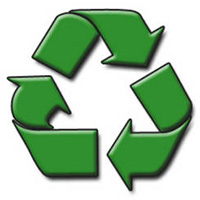
Recycling Plastic
Look through the plastic items in your recycling bin and identify the recycling code found on each plastic. You should see one of the following symbols, although in some cases the alphabet code might not be included:

Each of these plastics is made out of different chemicals and, because they are different, they have different properties and different uses. HDPE (#2) is a rigid polymer and is good for holding liquids, whereas LDPE (#4) is flexible and used to make trash bags.
Materials
• Food coloring
• Isopropyl “rubbing” alcohol (70%)
• Salt (Kosher or canning salt is preferable)
• Sturdy, transparent bottle with cap
• Variety of plastics cut into small pieces that will fit into the bottle
• Water
Be Safe: Rubbing alcohol is flammable and may cause serious eye irritation. Getting alcohol on a cut or open sore may also sting. Adult supervision is recommended.
Experiment
Half-fill the bottle with isopropyl alcohol and add a drop of food coloring. Add water until the bottle is about ¾ full. Cap and shake the bottle and observe. Now add a heaping tablespoon of salt to the bottle and shake. The salt will most likely completely dissolve and so you will want to continue adding salt and shaking the solution until the salt just barely dissolves. (Patience needed!) What happens to the solution as more salt is added? Add different pieces of plastic to the bottle, shake it, and let it rest. Observe: Where are the plastics?
What’s happening?
Initially the two liquids are miscible (dissolving completely in each other regardless of the ratio). However, when salt is added to the point of a saturated salt solution (no more salt will dissolve), the liquid separates into two layers, with the bottom liquid layer being more highly colored.
Because water is more polar than isopropyl alcohol, it will tend to surround the charged sodium and chloride ions present in salt and the resulting saturated salt solution separates from the isopropyl alcohol. The result is two liquid layers, with salt water on the bottom and isopropyl alcohol on the top.
Plastic pieces added to the bottle will appear to float (or settle) in any number of places in and between the two liquid layers. This is because one of the properties that is unique for different plastics is their density. The least dense plastics will tend to float at the interface between the salt water and isopropyl alcohol layers. The most dense plastics may settle at the bottom of the bottle. See the table below for typical densities
|
Substance |
Density (g/mL) |
Commonly found* |
|
Isopropyl Alcohol |
0.79** |
|
|
Salt Water*** |
1.20 |
|
|
Plastic #1 (PETE) |
1.35 |
Beverage bottles |
|
Plastic #2 (HDPE) |
0.94 |
Milk jugs |
|
Plastic #3 (PVC) |
1.34 |
Plumbing pipes |
|
Plastic #4 (LDPE) |
0.92 |
Shopping bags |
|
Plastic #5 (PP) |
0.91 |
Drinking straws |
|
Plastic #6 (PS) |
1.04 |
Take-out containers |
*https://plasticoceans.org/7-types-of-plastic/
**This is the density of pure isopropyl alcohol.
***Saturated solution—no more salt will dissolve.
When mixed plastics from a recycling bin are brought to a recycling facility, one way in which facilities separate them is by their density. This gets the plastics that are made of the same compounds together.
References
https://www.youtube.com/watch?v=wEG_JfLepU8
https://pubs.acs.org/doi/10.1021/ed500830w
To view past “ChemShorts for Kids” activities, go to:
https://chicagoacs.org/ChemShorts.
- PAUL BRANDT
Upcoming Events

UPCOMING EVENTS
|
May 10 |
Articles due for the June 2023 Bulletin issue |
|
May 11 |
Chicago Board of Directors Meeting |
|
May 19 |
Chicago ACS Monthly Program Meeting |
|
May 20 |
Argonne National Laboratory Open House |
|
June 7 |
112th Willard Gibbs Award Celebration (In-person meeting only) |
|
June 8 |
Chicago Board of Directors Meeting |
|
June 20 |
|
|
June 27 |
Please also refer to the Section’s website chicagoacs.org and social media accounts.
Board & Committee Members

2023 Chicago ACS Section Officers
|
Chair Chair-Elect Past Chair Vice Chair Secretary Treasurer |
Margaret Schott Vivian Sullivan Mark Cesa Paul Brandt Amy Balija Michael Morello |
chair-at-chicagoacs.org chair-elect-at-chicagoacs.org past-chair-at-chicagoacs.org vice-chair-at-chicagoacs.org secretary-at-chicagoacs.org treasurer-at-chicagoacs.org |
Masthead
Bulletin Information
April 2023, Vol. 110, No. 5
Published by the Chicago Section of the American Chemical Society
https://chicagoacs.org
Editors: Amber Arzadon and Irene Cesa
editor-at-chicagoacs.org
Digital Editor: Josh Kurutz
Proofreaders: Helen Dickinson and Ken Fivizzani
ACS Chicago Section Office
Address: 1400 Renaissance Drive,
Suite 312
Park Ridge, IL 60068 (847) 391-9091
office-at-chicagoacs.org
Social links
Follow ChicagoACS on social media!
Instagram: https://www.instagram.com/ChicagoACS/
Facebook: https://www.facebook.com/ChicagoACS
LinkedIn: https://www.linkedin.com/groups/1854603/

